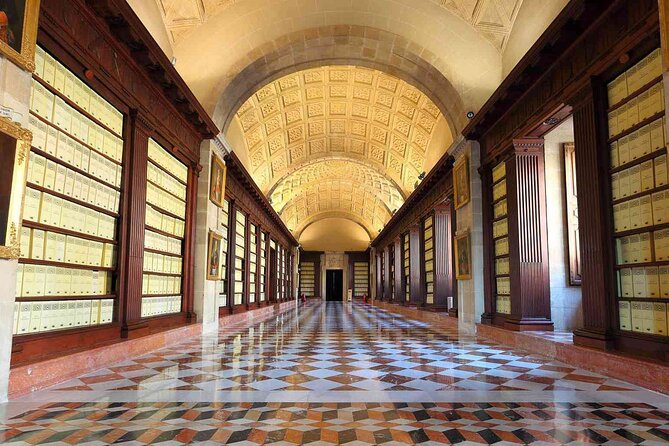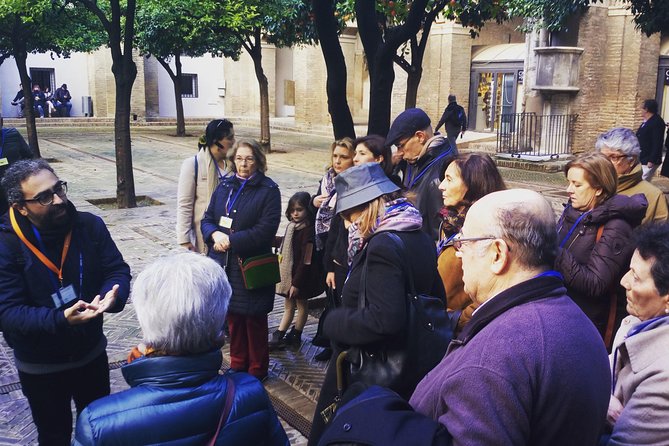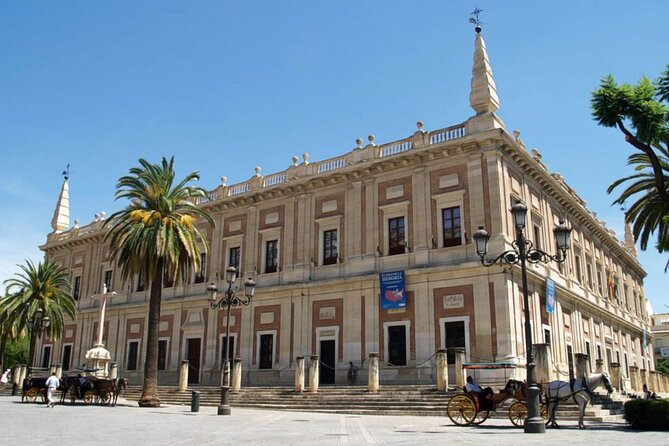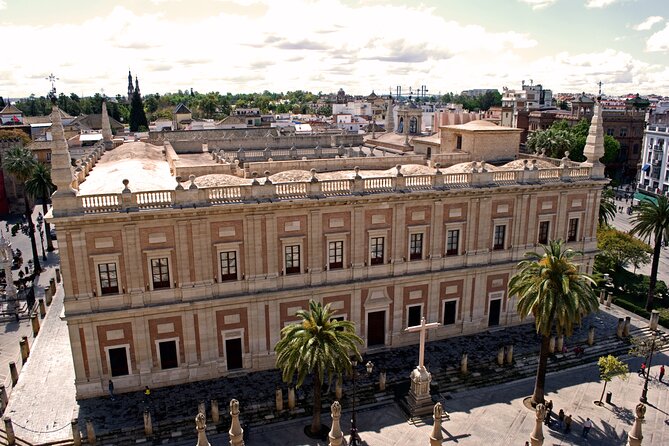The Archive of the Indies Guided Tour offers visitors a chance to explore Spain’s colonial history. Led by knowledgeable heritage experts, this 1 hour and 45-minute experience takes participants on an immersive journey through the significance of the Archive, Seville Cathedral, and the Alcázar. With a maximum group size of 30, the tour provides personalized attention as it navigates the rich cultural and historical importance of these UNESCO World Heritage sites. Guests can expect to skip the lines and enjoy a comprehensive exploration that unveils the fascinating connections between these iconic landmarks.
Key Points

-
A guided tour of the UNESCO World Heritage-listed Archive of the Indies in Seville, Spain, providing insights into Spain’s colonial history.
-
The tour includes skip-the-line access to Seville Cathedral and the Giralda, exploring the historical connections between these significant landmarks.
-
The tour is led by a heritage expert guide, who offers personalized attention and in-depth commentary on the Archive’s historical uses and transformation over time.
-
The tour lasts for 1 hour and 45 minutes and has a maximum group size of 30 travelers, ensuring an intimate and informative exploration of the site.
-
The tour’s convenient meeting point, wheelchair and stroller accessibility, and positive reviews from previous participants suggest an enriching and memorable experience.
Overview of the Tour

The guided tour of the Archive of the Indies in Seville, Spain, allows visitors to skip the line and gain access to both the Seville Cathedral and The Giralda.
The tour spans a duration of 1 hour and 45 minutes with a maximum group size of 30 travelers. Visitors will explore the historical connections between the Archive, the Cathedral, and the Alcázar of Seville, as the Archive of the Indies is a UNESCO World Heritage Site.
This tour provides personalized attention from a heritage expert guide, who’ll lead guests through two floors of the Archive, sharing insights about the building’s historical uses prior to its current role as the General Archive of the Indies.
Loving the local insights? Here are more guided experiences we recommend in Seville
Historical Significance of the Sites
The Seville Cathedral stands as the largest Gothic cathedral in the world, a testament to the city’s rich history and architectural prowess.
The Archive of the Indies, a UNESCO World Heritage Site, further exemplifies Seville’s pivotal role in Spain’s colonial endeavors, housing a vast collection of documents that chronicle the country’s expansive maritime empire.
These two iconic landmarks, along with the nearby Alcázar of Seville, form a historical triad, each institution playing a crucial part in Spain’s global exploration and administration.
The guided tour offers visitors a unique opportunity to explore the intricate connections between these sites, shedding light on the influential role Seville played in shaping the course of history.
Highlights of the Tour Experience

Exploring the two floors of the Archive of the Indies is a highlight of the guided tour, offering visitors a unique glimpse into the historical uses of the building prior to its current role as the General Archive of the Indies.
Led by a knowledgeable heritage expert, the tour provides personalized attention, guiding participants through the archive’s storied past. Visitors will learn about the building’s transformation, from its earlier incarnations to its present-day status as a UNESCO World Heritage Site.
The tour also includes skip-the-line admission to the impressive Seville Cathedral and the iconic Giralda, further enhancing the overall experience.
With a maximum group size of 30 travelers, the tour ensures an intimate and informative exploration of these historic Sevillian landmarks.
Meeting Point and Accessibility

The meeting point for the guided tour is at the main entrance of the Archivo de Indias, located at Av. de la Constitución in Seville’s historic Casco Antiguo district.
Tour participants can expect the guide to be waiting there, easily identifiable by their accreditation. The tour is wheelchair and stroller accessible, and the location is conveniently situated near public transportation options.
The Archive of the Indies is a UNESCO World Heritage Site, and this guided tour provides an opportunity to explore its historical significance.
With personalized attention from a heritage expert, visitors can explore the building’s past uses and its connections to Seville Cathedral and the Alcázar of Seville.
Positive Reviews and Ratings
Travelers have showered the guided tour with overwhelmingly positive reviews, awarding it a flawless 5.0-star rating across all 6 evaluations.
Reviewers consistently praise the tour guide’s expertise, highlighting the informative and insightful historical commentary provided throughout the experience. One participant remarked that the guide’s deep knowledge of the Archive of the Indies and its connections to the Seville Cathedral and Alcázar brought the destination’s rich heritage to life.
Visitors also appreciate the personalized attention and small group setting, which allows for more engaging discussions. The tour’s stellar ratings underscore its ability to deliver an immersive and enriching exploration of this UNESCO World Heritage Site.
- Alcazar and Cathedral of Seville Tour With Skip the Line Tickets
- Seville Highlights Bike Tour (English)
- White Villages and Ronda Day Tour From Seville
- Sevilla Food Tour: Tapas, Wine, History & Traditions
- Alcazar of Seville Reduced-Group Tour
- Flamenco Show at Tablao El Arenal With Drink and Optional Dinner or Tapas
Guided Tour of the Archive
The guided tour of the Archive of the Indies allows visitors to explore the historical significance of this UNESCO World Heritage Site, exploring its rich heritage and connections to Seville’s iconic landmarks.
During the 1-hour 45-minute experience, the knowledgeable guide leads a group of up to 30 travelers through two floors of the Archive, shedding light on the building’s past uses before it became the General Archive of the Indies.
The tour also includes:
-
Skip-the-line admission to Seville Cathedral, the largest Gothic cathedral in the world
-
Access to the towering Giralda, the bell tower of the cathedral
-
Insights into the historical links between the Archive, Cathedral, and Alcázar of Seville
-
Personalized attention from a heritage expert guide
Exploration of the Cathedral and Giralda

After exploring the historical Archive, visitors embark on a captivating journey through Seville Cathedral and its iconic Giralda tower, unlocking the secrets of these remarkable landmarks. The sheer scale and architectural grandeur of the cathedral, the largest Gothic structure in the world, leave a lasting impression. Ascending the Giralda’s 104 gently sloping ramps offers breathtaking panoramic views of Seville’s historic cityscape.
| Feature | Cathedral | Giralda |
|---|---|---|
| History | Constructed in the 13th century on the site of a former mosque | Originally the minaret of the Almohad mosque, later converted into a bell tower |
| Architecture | Renowned for its stunning Gothic style, including the enormous central nave and elaborate stained glass windows | Combines Moorish and Renaissance influences, with a distinctive Baroque top |
| Significance | A UNESCO World Heritage Site and one of Seville’s most iconic landmarks | Offers unparalleled views of the city, making it a must-visit destination |
Historical Connections Between the Sites
Exploring the historical connections between the Archive of the Indies, Seville Cathedral, and the Alcázar of Seville reveals the intricate tapestry of this city’s storied past.
These three sites are inextricably linked, each playing a crucial role in Spain’s exploration, colonization, and administration of its vast overseas empire.
The Archive of the Indies housed the records and documentation that detailed the vast commercial and governmental activities of the Spanish Empire.
Seville Cathedral, the largest Gothic cathedral in the world, stood as a symbol of Spain’s religious and cultural dominance.
The Alcázar of Seville, the royal palace, was the seat of power from which the empire was administered.
Together, these sites represent the pinnacle of Spain’s global influence and the enduring legacy of its colonial ventures.
Frequently Asked Questions
Can I Take Photographs Inside the Archive of the Indies?
Visitors are generally allowed to take photographs inside the Archive of the Indies, but they should check with the staff upon arrival as some restrictions may apply to protect the historic documents and building. Flash photography is typically prohibited.
Is There a Dress Code for the Tour?
There is no strict dress code for the tour, but visitors are generally expected to dress respectfully. Comfortable, modest clothing is recommended as the tour involves walking through historic buildings. Casual attire is fine, but avoid overly revealing or casual items.
What Language Is the Tour Conducted In?
The tour is conducted in English. The guide provides the tour in English to ensure all travelers can fully understand and appreciate the historical significance of the Archive of the Indies during their visit.
Are Food and Drinks Allowed During the Tour?
Food and drinks are typically not allowed during tours to protect the historical sites and artifacts. Visitors are usually asked to avoid consuming any food or beverages during the tour to maintain the preservation of the spaces.
Can the Tour Guide Provide Recommendations for Nearby Restaurants?
Yes, the knowledgeable tour guide can likely provide recommendations for nearby restaurants. They may suggest local eateries that offer authentic cuisine and provide insights into the area’s culinary scene to enhance the overall tour experience.
Recap
The Archive of the Indies Guided Tour provides an immersive exploration of Spain’s colonial history.
Participants can discover the significance of the Archive, Seville Cathedral, and the Alcázar, while enjoying skip-the-line access to the Cathedral and Giralda.
Led by knowledgeable heritage experts, the tour offers personalized attention and a comprehensive understanding of the cultural and historical importance of these UNESCO World Heritage sites.
More Guided Tours in Seville
- 5-Days Discovering Birds of Portugal and Spain With Guide
- Seville: Palacio De Las Dueñas Entry Ticket and Guided Tour
- Seville: Cathedral Guided Tour With Optional Alcázar
- Seville: Guided Sunset Bike Tour
- Seville: Flavors of Andalucía Guided Food Tour With Tastings
- Seville: Guided Tour of Cathedral of Seville & Giralda Tower
More Tours in Seville
More Tour Reviews in Seville
Not for you? Here's more things to do in Seville we have recnetly reviewed
- 3 Best Canoe And Kayak Experiences In Seville
- 12 Best 2 Day Tours In Seville
- 25 Best Canoe And Kayak Experiences In Seville
- 25 Best Cruises And Boat Tours In Seville
- 13 Best Food Tours In Seville
- 12 Best Full-Day Tours In Seville
- 15 Best Photography Experiences In Seville
- 13 Best Dining Experiences In Seville
- 13 Best Dinner Tours In Seville
- 7 Best Lunch Experiences In Seville
- Horse-Drawn Carriage Private Ride Through Seville
- Caminito Del Rey. 1 Day Excursion.
